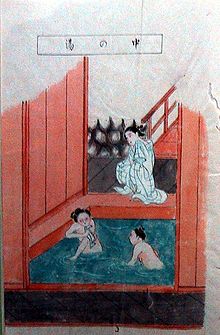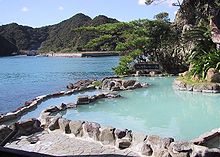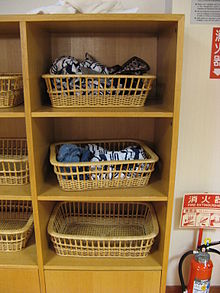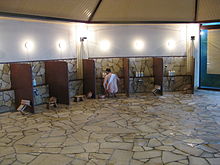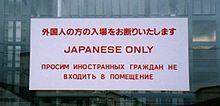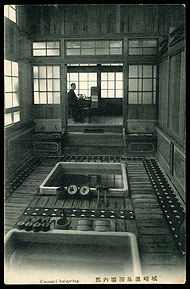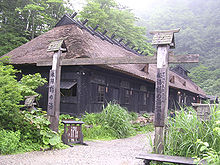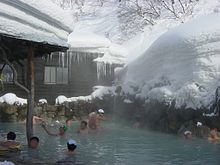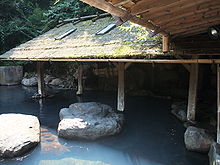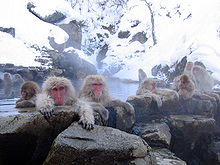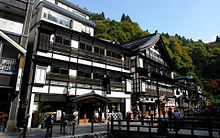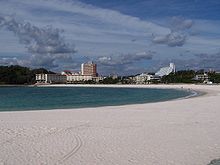- Onsen
-
An onsen (温泉) is a term for hot springs in the Japanese language, though the term is often used to describe the bathing facilities and inns around the hot springs. As a volcanically active country, Japan has thousands of onsen scattered along its length and breadth. Onsen were traditionally used as public bathing places and today play a central role in directing Japanese domestic tourism.
Onsen come in many types and shapes, including outdoor (露天風呂 or 野天風呂 roten-buro or noten-buro) and indoor baths. Baths may be either public run by a municipality or private (内湯 uchiyu) often run as part of a hotel, ryokan or bed and breakfast (民宿 minshuku).
Onsen are a central feature of Japanese tourism often found out in the countryside but there are a number of popular establishments still found within major cities. They are a major tourist attraction drawing Japanese couples, families or company groups who want to get away from the hectic life of the city to relax. Japanese often talk of the virtues of "naked communion" (裸の付き合い hadaka no tsukiai)[1] for breaking down barriers and getting to know people in the relaxed homey atmosphere of a ryokan with an attached onsen. Japanese television channels often feature special programs about local onsens.
The presence of an onsen is often indicated on signs and maps by the symbol ♨ or the kanji, 湯 (yu, meaning "hot water"). Sometimes the simpler hiragana character ゆ (yu) is used, to be understandable to younger children.
Traditionally, onsen were located outdoors, although a large number of inns have now built indoor bathing facilities as well. Onsen by definition use naturally hot water from geothermally heated springs. Onsen should be differentiated from sentō, indoor public bath houses where the baths are filled with heated tap water. The legal definition of an onsen includes that its water must contain at least one of 19 designated chemical elements, including radon and metabolic acid and be 25 °C or warmer before being reheated. Stratifications exist for waters of different temperatures. Major onsen resort hotels often feature a wide variety of themed spa baths and artificial waterfalls in the bathing area utaseyu (打たせ湯).
Onsen water is believed to have healing powers derived from its mineral content. A particular onsen may feature several different baths, each with water with a different mineral composition. The outdoor bath tubs are most often made from Japanese cypress, marble or granite, while indoor tubs may be made with tile, acrylic glass or stainless steel. Different onsen also boast about their different waters or mineral compositions, plus what healing properties these may contain. Other services like massages may be offered.
Traditionally, men and women bathed together at the onsen and sentō but single-sex bathing has become legalized as the norm since the opening of Japan to the West during the Meiji period. Mixed bathing persists at some special onsen (konyoku) in the rural areas of Japan, which usually also provide the option of separate "women-only" baths or different hours for the two sexes. Children of either sex may be seen in both the men's and the women's baths.
People often travel to onsen with work colleagues, friends, couples or their families.
Contents
Etiquette
Ensuring cleanliness
At an onsen, as at a sentō, all guests are expected to wash their bodies and rinse themselves thoroughly before entering the hot water. Bathing stations are equipped with stools, faucets, wooden buckets, and toiletries such as soap and shampoo; nearly all onsen also provide removable shower heads for bathing convenience. Entering the onsen while still dirty or with traces of soap on the body is socially unacceptable.[2]
Swimsuits
Bathers are not normally allowed to wear swimsuits in the baths. However, some modern onsen with more of a waterpark atmosphere require their guests to wear a swimming suit in their mixed baths.
Towels
Onsen guests generally bring a small towel with them to use as a wash cloth. The towel can also provide a modicum of modesty when walking between the washing area and the baths. Some onsen allow one to wear the towel into the baths, while others have posted signs prohibiting this, saying that it makes it harder to clean the bath. It is sometimes against the rules to immerse or dip towels in the onsen bath water, since this can be considered unclean. In this latter case, people normally set their towels off to the side of the water when enjoying the baths, or place their folded towels on top of their heads.
Noise
Onsen vary from quiet to noisy, some play piped music and often feature gushing fountains. Bathers will engage in conversation in this relaxed situation. There are usually prohibitions against rowdiness in the washing and bathing areas. A small amount of excess energy and splashing around is usually tolerated from children, however.
Tattoos
Many onsen ban bathers with tattoos, which in Japan are traditionally perceived as a badge of criminality—Yakuza traditionally have elaborate tattoos. Despite this background reason, the rule is often enforced strictly against all, including foreigners, women, and even when tattoos are small and "peaceful".[3][4][5]
Therapy
The volcanic nature of Japan provides plenty of springs. When the onsen's water contains distinctive minerals or chemicals, the onsen establishments display what type of onsen it is.
Some examples of types of onsen include:
- Sulphur onsen (硫黄泉 iō-sen)
- Sodium chloride onsen (ナトリウム泉 natoriumu-sen)
- Hydrogen carbonate onsen (炭酸泉 tansan-sen)
- Iron onsen (鉄泉 tetsu-sen)
In Japan, it is said onsen have various medical effects.[6] Japanese people believe that a good soak in proper onsen heals aches, pains and diseases, and visit onsen to treat the illnesses, such as arthralgia, chronic skin diseases, diabetes, constipation, menstrual disorders and so on.[6]
These medical benefits have given onsen a central role in balneotherapy which is called "Onsen Therapy" (温泉療法 onsen-ryōhō). Onsen Therapy is a comprehensive bathing treatment conducted to maintain health, normalize dysfunctions and prevent illness.[6]
Risks
Although millions of Japanese bathe in onsen every year with few noticeable side effects, there are still contraindications to onsen usage, such as high blood pressure or heart disease.[7]
In recent years, Legionella bacteria have been found sporadically in onsen with poor sanitation.[8][9] Revelations of poor sanitary practices at some onsen have led to improved regulation by hot spring communities to maintain their reputation.[10]
There have been reports of infectious disease found in hot bodies of water worldwide, such as:
- Athlete's foot[citation needed]
- Various Naegleria species.[11] While studies have found the presence of Naegleria in hot spring waters, the worrisome Naegleria fowleri amoeba has not been identified.[11] Nevertheless, less than 5 cases have been seen historically in Japan, although not conclusively linked to onsen exposure.[12]
Many onsen have posted notices for visitors, reminding anyone with open cuts, sores, or lesions to not bathe. Additionally, in recent years onsen are increasingly adding chlorine to their waters to prevent infection, although many onsen purists seek natural, unchlorinated onsen that instead does not recycle its water, cleaning baths daily.[10] These precautions as well as proper onsen usage (i.e. not placing the head underwater, washing thoroughly before entering the bath) greatly reduces any overall risk to bathers.
Incidents
In 2001, onsen owners in the port city of Otaru, Hokkaido referred to incidents of rowdy Russian fishermen bothering other customers and causing lost businesses as reason to refuse service to anyone not Japanese.[13][14] This issue was highlighted in February 2001, when naturalized-Japanese Debito Arudou and two co-plaintiffs sued Yunohana Onsen in Otaru, Hokkaidō, for openly refusing service to customers because of their race. Yunohana Onsen lost the lawsuit in November 2002.[15]
In another case of discrimination, Kurokawa Onsen Hotel in Kumamoto Prefecture ran into legal trouble when leprosy patients were refused entry.[16] Leprosy is not contagious once treated, and laws that used to force seclusion on leprosy patients have long been overturned.
Out of the thousands of onsen in operation in Japan, there have been few reports of businesses practicing discrimination of this kind.
Selected onsen
- Akagi, Gunma
- Akayu, Yamagata
- Arima Onsen (ja:有馬温泉), Kobe, Hyōgo, one of the most famous onsen outside Japan, in Kobe
- Asamushi Onsen (ja:浅虫温泉), Aomori
- Aso, Kumamoto, a famous Onsen area alongside Mount Aso, an active volcano
- Atami Onsen (ja:熱海温泉), Atami, Shizuoka, major onsen resort town near Tokyo
- Dōgo Onsen (ja:道後温泉), Ehime
- Futamata, Hokkaidō
- Gero, Gifu - famous for its free open bath on riverbank of Hida River
- Getō Onsen (ja:夏油温泉), Iwate
- Ginzan Onsen (ja:銀山温泉), Obanazawa, Yamagata
- Hakone, Kanagawa, famous onsen resort town near Tokyo
- Hanamaki, Iwate
- Hirayu Onsen (ja:平湯温泉), Takayama, Gifu
- Hokkawa Onsen (ja:北川温泉 (静岡県)), Shizuoka
- Ibusuki Onsen, Kagoshima
- Itō, Shizuoka
- Iwamuro, Niigata, famous for onsen since the Edo period
- Jigokudani, Nagano
- Jōzankei Onsen (ja:定山渓温泉), Hokkaidō
- Kakeyu Onsen (ja:下鹿教湯温泉), Nagano
- Kanzanji Onsen (ja:舘山寺温泉), Shizuoka
- Kindaichi Onsen, Iwate
- Kinosaki (ja:城崎温泉), Hyōgo
- Kinugawa Onsen, Tochigi
- Kurokawa Onsen Village, Kumamoto
- Kusatsu Onsen (ja:草津温泉), Gunma, one of the most famous onsen outside Japan
- Nagaragawa Onsen, Gifu, Gifu
- Sawatari, Gunma
- Shima, Gunma
- Naruko, Miyagi
- Noboribetsu, Hokkaidō
- Nuruyu Onsen, Kumamoto
- Nyūtō Onsen (ja:乳頭温泉郷), Akita
- Onneyu Onsen (ja:温根湯温泉), Hokkaidō
- Sabakoyu Onsen, Fukushima, the oldest community onsen in Japan
- Sakunami Onsen, Miyagi
- Senami Onsen (ja:瀬波温泉), Niigata
- Shimabara, Nagasaki
- Shimobe Onsen (ja:下部温泉), Yamanashi
- Shiobara Onsen (ja:塩原温泉郷), Tochigi
- Shuzenji Onsen (ja:修善寺温泉), Shizuoka
- Sōunkyo Onsen (ja:層雲峡温泉), Hokkaidō
- Sukayu Onsen, Aomori
- Sumatakyō Onsen (ja:寸又峡温泉), Shizuoka
- Suwa, Nagano
- Takanoyu Onsen, Akita
- Takaragawa, Gunma, one of the largest konyoku roten-buro (outdoor mixed bath) in Japan
- Takarazuka, Hyōgo
- Tara, Saga
- Tōyako, Hokkaidō, Hokkaidō
- Tsukioka Onsen (ja:月岡温泉), Niigata
- Tsurumaki Onsen (ja:鶴巻温泉), Kanagawa
- Unazuki Onsen (ja:宇奈月温泉), Kurobe, Toyama
- Wakura Onsen (ja:和倉温泉), Nanao, Ishikawa
- Yubara Onsen (ja:湯原温泉), Okayama, one of the largest co-ed baths at the foot of Yubara dam
- Yudanaka Onsen (ja:湯田中渋温泉郷), Nagano
- Yufuin, Oita, one of the most famous onsen outside Japan
- Yugawara, Kanagawa
- Yunogo Onsen, Okayama
- Yunokawa Onsen, Hokkaidō
- Yuzawa, Niigata
- Zaō Onsen, Yamagata
- Awara Onsen (ja:芦原温泉), Awara, Fukui
- Awazu Onsen (ja:粟津温泉), Komatsu, Ishikawa
- Beppu Onsen, Beppu, Ōita, famous for its multi-coloured baths
- Ikaho Onsen (ja:伊香保温泉), Ikaho, Gunma
- Kaike Onsen (ja:皆生温泉), Yonago, Tottori
- Katayamazu Onsen (ja:片山津温泉), Kaga, Ishikawa
- Kawayu Onsen (ja:川湯温泉), Tanabe, Wakayama
- Misasa Onsen (ja:三朝温泉), Misasa, Tottori
- Nanki-Katsuura Onsen (ja:南紀勝浦温泉), Nachikatsuura, Wakayama
- Nanki-Shirahama Onsen (ja:南紀白浜温泉), Shirahama, Wakayama
- Ryujin Onsen (ja:龍神温泉), Tanabe, Wakayama, one of Japan's famous three beautifying onsen
- Tsubame Onsen (ja:燕温泉), Niigata - famous for its free open konyoku (mixed) onsen
- Yamanaka Onsen (ja:山中温泉), Kaga, Ishikawa
- Yamashiro Onsen (ja:山代温泉), Kaga, Ishikawa
- Yumura Onsen (ja:湯村温泉 (兵庫県)), (Shin'onsen), Hyōgo
- Yunomine Onsen (ja:湯の峰温泉), Tanabe, Wakayama, site of the UNESCO World Heritage Tsuboyu bath
See also the Japanese Wikipedia articles List of hot springs in Japan and Gallery of photographs of Japanese hot springs.
See also
References and notes
- ^ This term should be carefully differentiated from the word skinship (スキンシップ sukinshippu) which refers to the benefits of physical contact, for instance, on babies by their mothers.
- ^ In very isolated onsen, where there is no possibility to use soap before entering in the bath, onsen users are expected to at least rinse their body with the water of the bath before entering it.
- ^ Covering the offending tattoo with sticking plaster can sometimes solve the problem. "Onsen Warnings and Hassles"
- ^ Tattoo in Japan (2009-12-22). "Tattoo in Japan". Boing Boing. http://boingboing.net/2009/12/22/tattoo-in-japan.html. Retrieved 2010-12-07.
- ^ "Sunnypages - Tokyo reviews by English speakers". Sunnypages.jp. http://www.sunnypages.jp/contents/detail/146. Retrieved 2010-12-07.
- ^ a b c Getting into hot water for health. The Japan Times. May 25, 2003.
- ^ "Hot Spring Treatment|Hot Spring Encyclopedia|ONSEN|BEPPU CITY|". City.beppu.oita.jp. http://www.city.beppu.oita.jp/01onsen/english/03hyakka/ryouyou.html. Retrieved 2010-12-07.
- ^ H. Miyamoto; S. Jitsurong, R. Shiota, K. Maruta, S. Yoshida, E. Yabuuchi (1997). "Molecular determination of infection source of a sporadic Legionella pneumonia case associated with a hot spring bath". Microbiol Immunol. 41 (3): 197–202. PMID 9130230.
- ^ Eiko Yabuuchi; Kunio Agata, Kansenshogaku zasshi (Kansenshogaku zasshi) (2004). "An outbreak of legionellosis in a new facility of hot spring Bath in Hiuga City". Kansenshogaku zasshi 78 (2): 90–98. ISBN 0387-5911. PMID 15103899. http://cat.inist.fr/?aModele=afficheN&cpsidt=15675965.
- ^ a b 'Onsen': know what you're getting into (The Japan Times) http://search.japantimes.co.jp/cgi-bin/nn20040814a5.html
- ^ a b Shinji Izumiyama; Kenji Yagita, Reiko Furushima-Shimogawara, Tokiko Asakura, Tatsuya Karasudani, Takuro Endō (07 2003). "Occurrence and Distribution of Naegleria Species in Thermal Waters in Japan". The Journal of Eukaryotic Microbiology 50 (s1): 514–5. doi:10.1111/j.1550-7408.2003.tb00614.x. PMID 14736147. http://www.blackwell-synergy.com/doi/full/10.1111/j.1550-7408.2003.tb00614.x?cookieSet=1.
- ^ Yasuo Sugita; Teruhiko Fujii, Itsurou Hayashi, Takachika Aoki, Toshirō Yokoyama, Minoru Morimatsu, Toshihide Fukuma & Yoshiaki Takamiya (05 1999). "Primary amebic meningoencephalitis due to Naegleria fowleri: An autopsy case in Japan". Pathology International 49 (5): 468–70. doi:10.1046/j.1440-1827.1999.00893.x. PMID 10417693. http://www.blackwell-synergy.com/links/doi/10.1046/j.1440-1827.1999.00893.x.
- ^ Charles Scanlon (2001-02-01). "Bath house in hot water". BBC News. http://news.bbc.co.uk/2/hi/asia-pacific/1147784.stm. Retrieved 2003-11-21.
- ^ Michael Hoffman (2002-04-21). "Quiet after Otaru onsen storm - Hokkaido public forum finds birthplace no bar to a bath". Japan Times. http://search.japantimes.co.jp/cgi-bin/fl20020421a6.html.
- ^ "Racist Japanese bathhouse fined". BBC News. 2002-11-11. http://news.bbc.co.uk/2/hi/asia-pacific/2442411.stm.
- ^ "Japan lepers reject spa apology". BBC News. 2003-11-21. http://news.bbc.co.uk/2/hi/asia-pacific/3228200.stm.
Further reading
- Hotta, Anne, and Yoko Ishiguro. A Guide to Japanese Hot Springs. New York: Kodansha America, 1986. ISBN 0870117203.
- Fujinami, Kōichi. Hot Springs in Japan. Tokyo: Board of Tourist Industry, Japanese Government Railways; Maruzen Company, Ltd., 1936.
- Neff, Robert. Japan's Hidden Hot Springs. Rutland, Vermont: Charles E. Tuttle, 1995. ISBN 0804819491.
- Seki, Akihiko, and Elizabeth Heilman Brooke. The Japanese Spa: A Guide to Japan's Finest Ryokan and Onsen. Boston: Tuttle Publishing, 2005. ISBN 080483671X. Reprinted as Ryokan: Japan's Finest Spas and Inns, 2007. ISBN 0804838399.
External links
- OnsenJapan.net Interactive Google map with easy-to-read icons, pictures, and reviews
- Secret Onsen a database with more than 125 onsen all around Japan
- Onsen Blog Providing Onsen info from an onsen lover in Japan
- Onsen of Fukuoka Prefecture from official page of Fukuoka Prefecture Tourism Association
- Guide around Yudanaka Onsen, Shibu Onsen and Jigokudani Monkey park onsen
- Japan Onsen A mountain onsen guide for the Shin-etsu region of the Japan Alps
- Tanabe City Kumano Tourism Bureau Indepth information on onsen in Wakayama Prefecture
Categories:- Bathing in Japan
- Hot springs of Japan
- Japanese words and phrases
Wikimedia Foundation. 2010.


